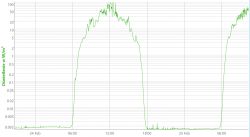Hello
Looking for the most optimal solution to control 10+ sensors from an android app , project assumptions are:
- Each sensor is equipped with a light sensor with AC converter and RED/GREEN diode
- The value from the sensor is sent to the application, depending on its value android sends a signal to light up the RED or Green diode
- The sensor can be added/removed from the network at any time without interfering with the sensor software.
- The android system can be 20+ metres from the sensors.
- The cost of implementation must be as low as possible.
From what I have been able to see on google ( and I am not familiar with communication modules) I see here a combination of CC2530 + ESP8266 modules.
Question :
Is my reasoning correct ? - Is it possible to build such a network on these modules ? Do you need additional microcontrollers for the CC2530 or can they be used without additional microcontrollers ?
Will the bridge between Zigbee and WiFi be an ESP8266 module or do you also need a microcontroller for it ?
If you need to use microcontrollers - ATMEGA or ATTiny - are there any at a price below 5PLN - it is important to have as little additional electronics as possible for the modules
CC2530 + ESP8266.
Or maybe my whole concept is wrong and zigbee is not needed here ?
Please give me any suggestions so I can understand it all better.
Thank you and best regards
D.
Looking for the most optimal solution to control 10+ sensors from an android app , project assumptions are:
- Each sensor is equipped with a light sensor with AC converter and RED/GREEN diode
- The value from the sensor is sent to the application, depending on its value android sends a signal to light up the RED or Green diode
- The sensor can be added/removed from the network at any time without interfering with the sensor software.
- The android system can be 20+ metres from the sensors.
- The cost of implementation must be as low as possible.
From what I have been able to see on google ( and I am not familiar with communication modules) I see here a combination of CC2530 + ESP8266 modules.
Question :
Is my reasoning correct ? - Is it possible to build such a network on these modules ? Do you need additional microcontrollers for the CC2530 or can they be used without additional microcontrollers ?
Will the bridge between Zigbee and WiFi be an ESP8266 module or do you also need a microcontroller for it ?
If you need to use microcontrollers - ATMEGA or ATTiny - are there any at a price below 5PLN - it is important to have as little additional electronics as possible for the modules
CC2530 + ESP8266.
Or maybe my whole concept is wrong and zigbee is not needed here ?
Please give me any suggestions so I can understand it all better.
Thank you and best regards
D.








